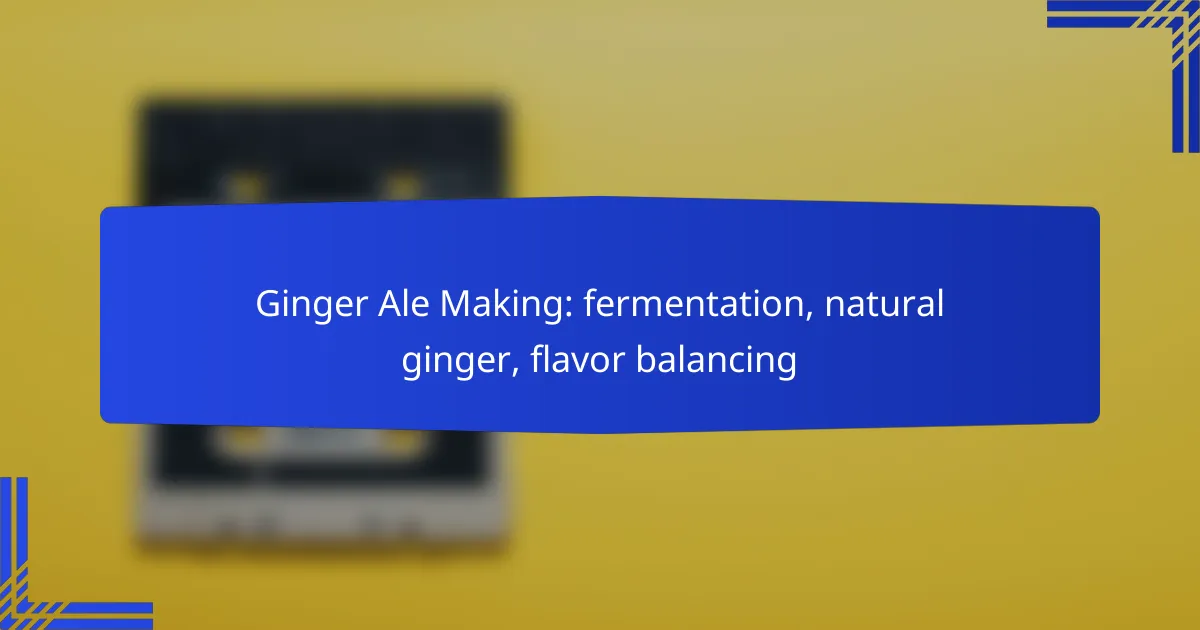Making ginger ale at home is a delightful way to enjoy a refreshing beverage that you can customize to your taste. By using fresh ginger, sugar, and water, along with a fermentation process, you can create a naturally carbonated drink that balances spice, sweetness, and fizz. This simple method not only produces a fizzy treat but also enhances the flavor through the interaction of the ingredients during fermentation.

How to make ginger ale at home in Australia?
Making ginger ale at home in Australia involves using fresh ginger, sugar, and water, along with a fermentation process to create carbonation. This simple method allows you to enjoy a refreshing beverage tailored to your taste preferences.
Using natural ginger
Natural ginger is the key ingredient in homemade ginger ale, providing both flavor and health benefits. Choose fresh, firm ginger roots, as they contain the most essential oils and flavor compounds. Peel and finely grate or chop the ginger to maximize its surface area, which enhances extraction during the brewing process.
For a balanced flavor, use about 100-200 grams of ginger per liter of water, adjusting based on your taste preference. The fresher the ginger, the more robust the flavor will be, so sourcing high-quality ginger is essential.
Fermentation process
The fermentation process is crucial for creating carbonation in ginger ale. Start by dissolving sugar in water, then add the grated ginger and a small amount of yeast, typically around 1-2 grams per liter. This mixture should be left at room temperature for about 24-48 hours, allowing the yeast to consume the sugar and produce carbon dioxide.
Monitor the fermentation closely; if left too long, the ginger ale can become overly fizzy or even explode. Once it reaches your desired level of carbonation, strain out the ginger and transfer the liquid to bottles, leaving some headspace for further fermentation.
Flavor balancing techniques
Balancing the flavors in your ginger ale is essential for a pleasant drinking experience. Start with the basic ginger and sugar mixture, then consider adding lemon juice or lime juice for acidity, which can brighten the overall flavor. A common ratio is about 50-100 ml of juice per liter of ginger ale.
You can also experiment with additional spices like cinnamon or cloves, but use them sparingly to avoid overpowering the ginger. Taste your mixture throughout the fermentation process to adjust sweetness and acidity as needed, ensuring a well-rounded final product.

What ingredients are needed for homemade ginger ale?
To make homemade ginger ale, you primarily need fresh ginger, sugar, and carbonated water. These ingredients work together to create a refreshing beverage that balances spice, sweetness, and fizz.
Fresh ginger
Fresh ginger is the key flavor component in ginger ale, providing its characteristic spiciness and warmth. When selecting ginger, look for firm, smooth roots with a strong aroma, as these indicate freshness and potency.
For a typical batch, using about 100-200 grams of fresh ginger will yield a robust flavor. You can adjust the amount based on your taste preference; more ginger will result in a spicier drink.
Sugar options
Sugar is essential for fermentation and sweetness in ginger ale. Common choices include white granulated sugar, brown sugar, or even honey, each imparting a different flavor profile. For a balanced taste, aim for around 100-200 grams of sugar per liter of water.
When using alternative sweeteners like honey or agave syrup, keep in mind that they may alter the fermentation process slightly, so adjustments in quantity may be necessary. Avoid artificial sweeteners, as they do not support fermentation.
Carbonated water
Carbonated water is what gives ginger ale its signature fizz. You can use store-bought sparkling water or carbonate your own using a soda maker. The level of carbonation can be adjusted based on personal preference.
For a homemade touch, aim for about 1 liter of carbonated water for every batch of ginger ale. If you’re using still water, remember to carbonate it before mixing in the ginger and sugar to achieve the desired effervescence.

What is the fermentation process for ginger ale?
The fermentation process for ginger ale involves converting sugars into alcohol and carbon dioxide using yeast. This natural process not only creates the beverage’s characteristic fizz but also enhances its flavor profile through the interaction of ginger and other ingredients.
Primary fermentation steps
To begin the fermentation of ginger ale, you’ll need to prepare a ginger bug, which is a mixture of ginger, sugar, and water that captures wild yeast. Combine this ginger bug with a mixture of water, sugar, and additional ginger in a fermentation vessel. Seal the container with an airlock to allow gases to escape while preventing contaminants from entering.
After mixing, gently stir the ingredients to dissolve the sugar fully. It’s crucial to maintain a warm environment, ideally between 20°C to 25°C (68°F to 77°F), to encourage yeast activity. Over the next few days, the yeast will consume the sugars, producing alcohol and carbonation.
Fermentation duration
The fermentation duration for ginger ale typically ranges from a few days to a couple of weeks, depending on the ambient temperature and desired flavor intensity. In warmer conditions, fermentation may complete in about 3 to 5 days, while cooler temperatures can extend this period to 10 to 14 days.
It’s advisable to taste the ginger ale periodically during fermentation to assess its flavor and carbonation levels. Once it reaches your preferred taste, you can proceed to bottle it, ensuring to leave some space for further carbonation in the bottles.
Signs of fermentation
Key signs of fermentation include bubbling in the mixture, which indicates carbon dioxide production, and a noticeable increase in the volume of the liquid due to gas release. You may also observe a frothy layer forming on the surface, a sign that the yeast is actively working.
Additionally, the aroma will change, becoming more pronounced and tangy as fermentation progresses. If you notice a decrease in bubbling or a lack of aroma, it may indicate that fermentation has slowed or stopped, and you should check the temperature and yeast activity.

How to balance flavors in ginger ale?
Balancing flavors in ginger ale involves adjusting sweetness, incorporating citrus, and using herbs and spices. Each element plays a crucial role in creating a harmonious beverage that enhances the natural ginger flavor while providing a refreshing taste.
Adjusting sweetness
Sweetness is a key component in ginger ale, as it helps to counteract the spiciness of ginger. Common sweeteners include sugar, honey, or agave syrup, with a typical range being 5-10% of the total volume. Start with less sweetener and gradually increase until you achieve a pleasing balance.
Be cautious with artificial sweeteners, as they can alter the flavor profile significantly. Taste your ginger ale throughout the process to ensure the sweetness complements rather than overwhelms the ginger’s natural heat.
Adding citrus
Citrus fruits like lemon, lime, or orange can brighten the flavor of ginger ale and add a refreshing acidity. A good starting point is the juice of half a lemon or lime per liter of ginger ale, adjusting to personal preference. Citrus not only enhances flavor but also helps to balance sweetness.
Consider using citrus zest as well for an aromatic boost. However, be mindful of the quantity; too much can overpower the ginger flavor. Always taste as you go to find the right balance.
Using herbs and spices
Incorporating herbs and spices can add depth to your ginger ale. Common choices include mint, basil, or even a pinch of cinnamon or cardamom. Start with small amounts, such as a few leaves or a dash of spice, to avoid overpowering the ginger flavor.
Experiment with combinations to find unique profiles that suit your taste. For instance, mint can provide a refreshing twist, while cinnamon adds warmth. Always allow the flavors to meld for a few hours before tasting, as they can intensify over time.

What are the health benefits of ginger ale?
Ginger ale offers several health benefits, primarily due to its key ingredient, ginger. This beverage can aid digestion, reduce inflammation, and help maintain hydration.
Digestive aid
Ginger ale can be a helpful digestive aid, especially when made with natural ginger. The compounds in ginger stimulate saliva and bile production, which can enhance digestion and alleviate discomfort from bloating or nausea.
For those experiencing digestive issues, consuming ginger ale in moderation may provide relief. Look for varieties that contain real ginger for the best effects.
Anti-inflammatory properties
The anti-inflammatory properties of ginger are well-documented, and ginger ale can harness these benefits. Ginger contains bioactive compounds like gingerol, which can help reduce inflammation in the body.
Regular consumption of ginger ale may assist in managing inflammation-related conditions, such as arthritis. However, it’s advisable to choose versions with minimal added sugars to maximize health benefits.
Hydration benefits
Staying hydrated is essential for overall health, and ginger ale can contribute to your daily fluid intake. The refreshing taste encourages drinking, making it a pleasant option for hydration.
While ginger ale can be hydrating, it’s important to balance it with water and other fluids, especially in hot weather or during physical activity. Opt for naturally flavored ginger ales to avoid excessive sugar intake, which can counteract hydration efforts.

What equipment is required for making ginger ale?
To make ginger ale, you need specific equipment that facilitates fermentation, bottling, and accurate measurement. Essential items include a fermentation vessel, bottling supplies, and measuring tools to ensure a successful brewing process.
Fermentation vessel
A fermentation vessel is crucial for creating ginger ale, as it provides a controlled environment for yeast to convert sugars into alcohol and carbonation. Common options include glass carboys, food-grade plastic buckets, or even large jars. Ensure the vessel has an airtight seal to prevent contamination while allowing gases to escape.
When selecting a fermentation vessel, consider its size based on your batch volume. A typical homebrew batch might range from 1 to 5 gallons (approximately 4 to 19 liters). Clean and sanitize the vessel thoroughly before use to avoid unwanted bacteria.
Bottling supplies
Bottling supplies are necessary for storing your finished ginger ale. You will need bottles, caps, and a capper. Glass bottles are preferred for their ability to withstand pressure, while plastic bottles can also be used for smaller batches.
When bottling, ensure that your bottles are clean and sanitized. Use a bottling wand to fill the bottles, leaving some headspace to allow for carbonation. Properly cap each bottle to maintain carbonation and prevent spoilage.
Measuring tools
Measuring tools are essential for accurately determining ingredients and maintaining consistency in your ginger ale. A scale for weighing ingredients, measuring cups for liquids, and a thermometer for monitoring temperatures are all important tools.
Using precise measurements helps achieve the desired flavor and carbonation levels. For example, using a hydrometer can help you track the fermentation progress by measuring the specific gravity of your mixture. Always calibrate your measuring tools to ensure accuracy before starting your brew.
